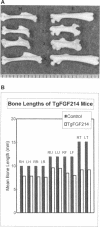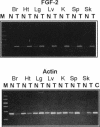Abstract
Basic fibroblast growth factor (FGF-2) is a pleiotropic growth factor detected in many different cells and tissues. Normally synthesized at low levels, FGF-2 is elevated in various pathologies, most notably in cancer and injury repair. To investigate the effects of elevated FGF-2, the human full-length cDNA was expressed in transgenic mice under control of a phosphoglycerate kinase promoter. Overexpression of FGF-2 caused a variety of skeletal malformations including shortening and flattening of long bones and moderate macrocephaly. Comparison by Western blot of FGF-2 transgenic mice to nontransgenic littermates showed expression of human FGF-2 protein in all major organs and tissues examined including brain, heart, lung, liver, kidney, spleen, and skeletal muscle; however, different molar ratios of FGF-2 protein isoforms were observed between different organs and tissues. Some tissues preferentially synthesize larger isoforms of FGF-2 while other tissues produce predominantly smaller 18-kDa FGF-2. Translation of the high molecular weight isoforms initiates from unconventional CUG codons and translation of the 18-kDa isoform initiates from an AUG codon in the FGF-2 mRNA. Thus the Western blot data from the FGF-2 transgenic mice suggest that tissue-specific expression of FGF-2 isoforms is regulated translationally.
Full text
PDF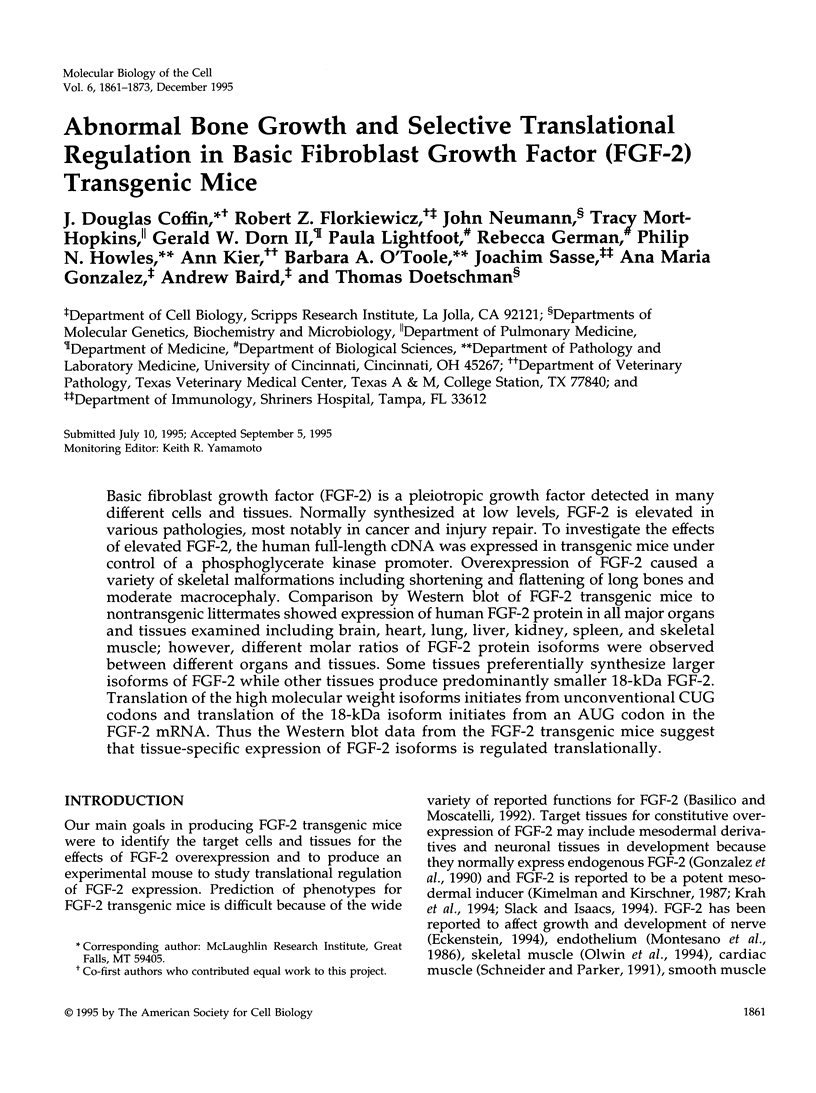

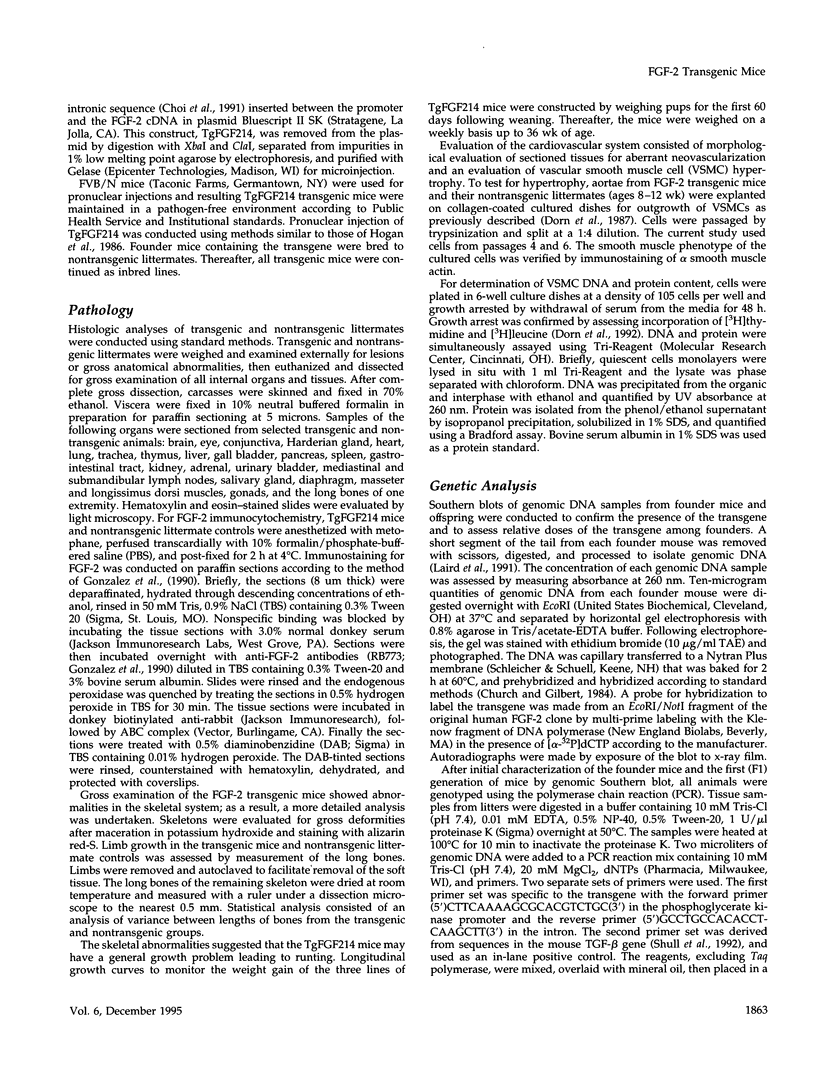
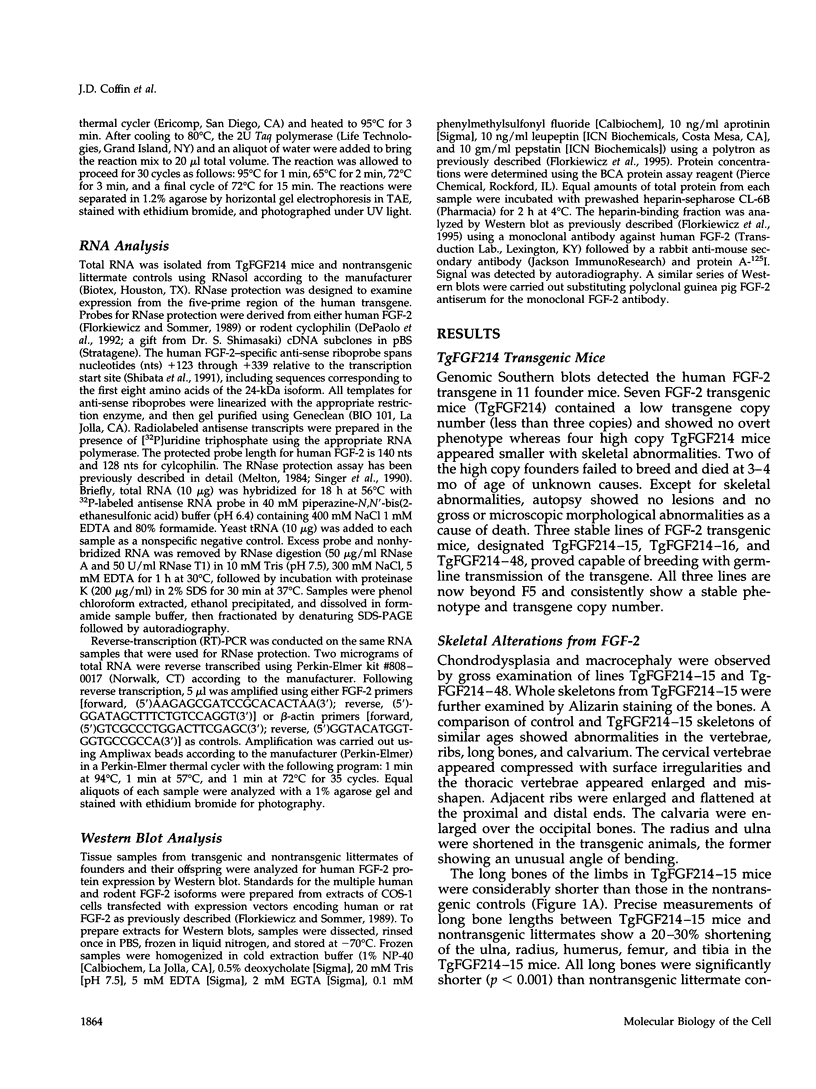
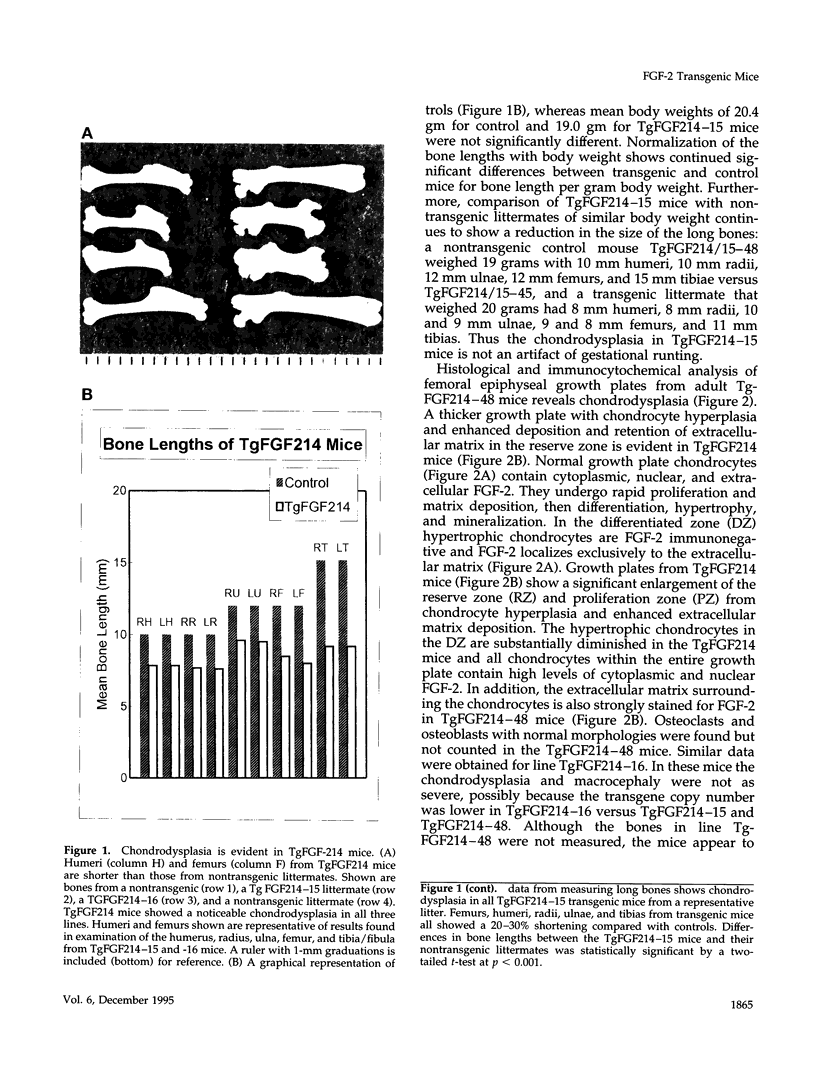
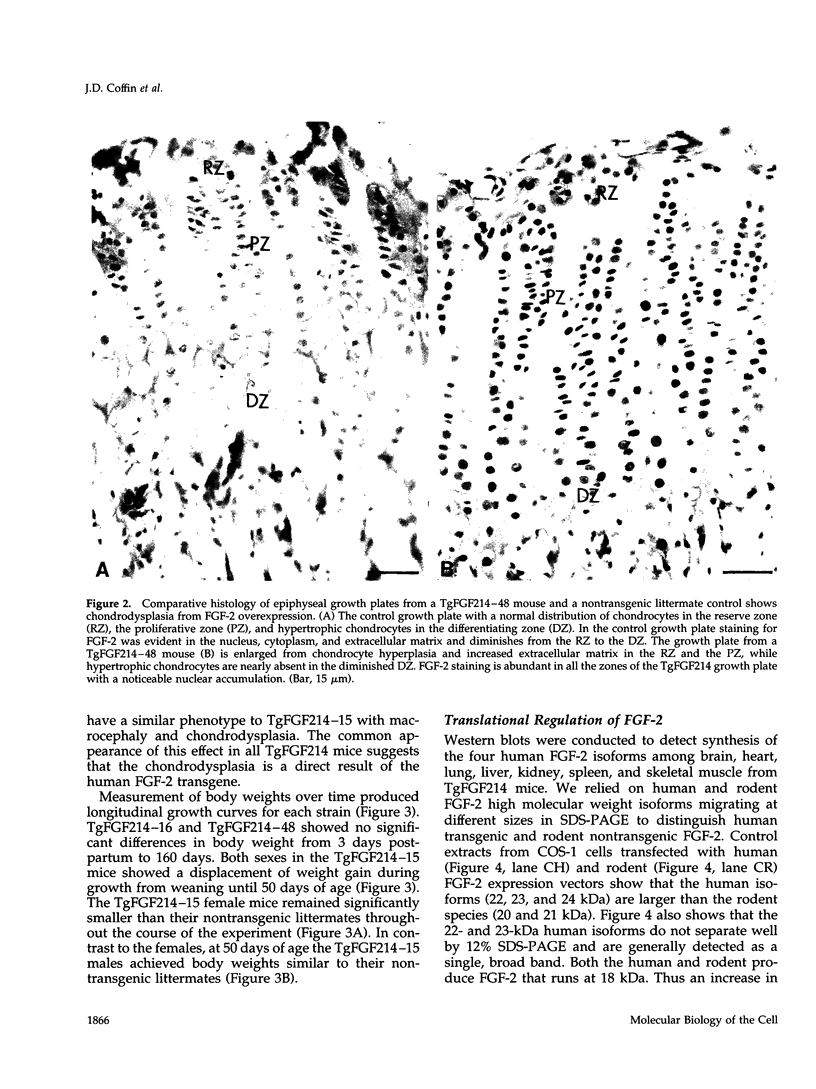
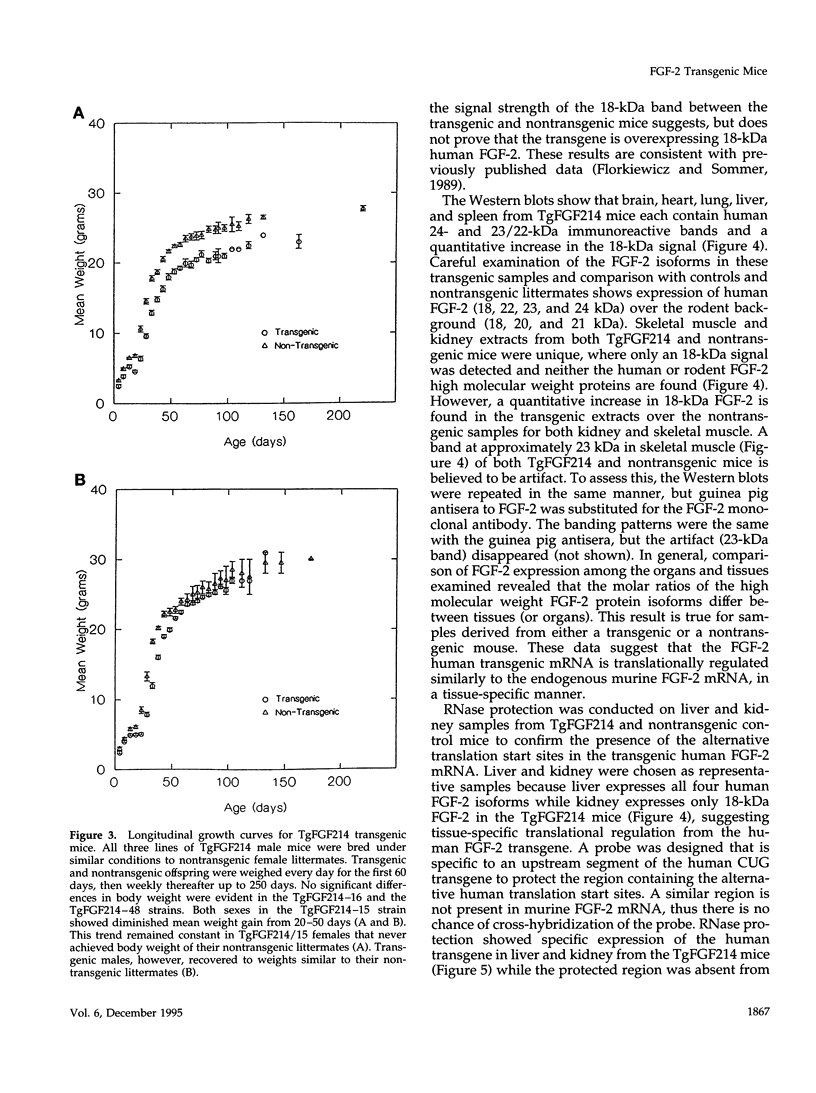
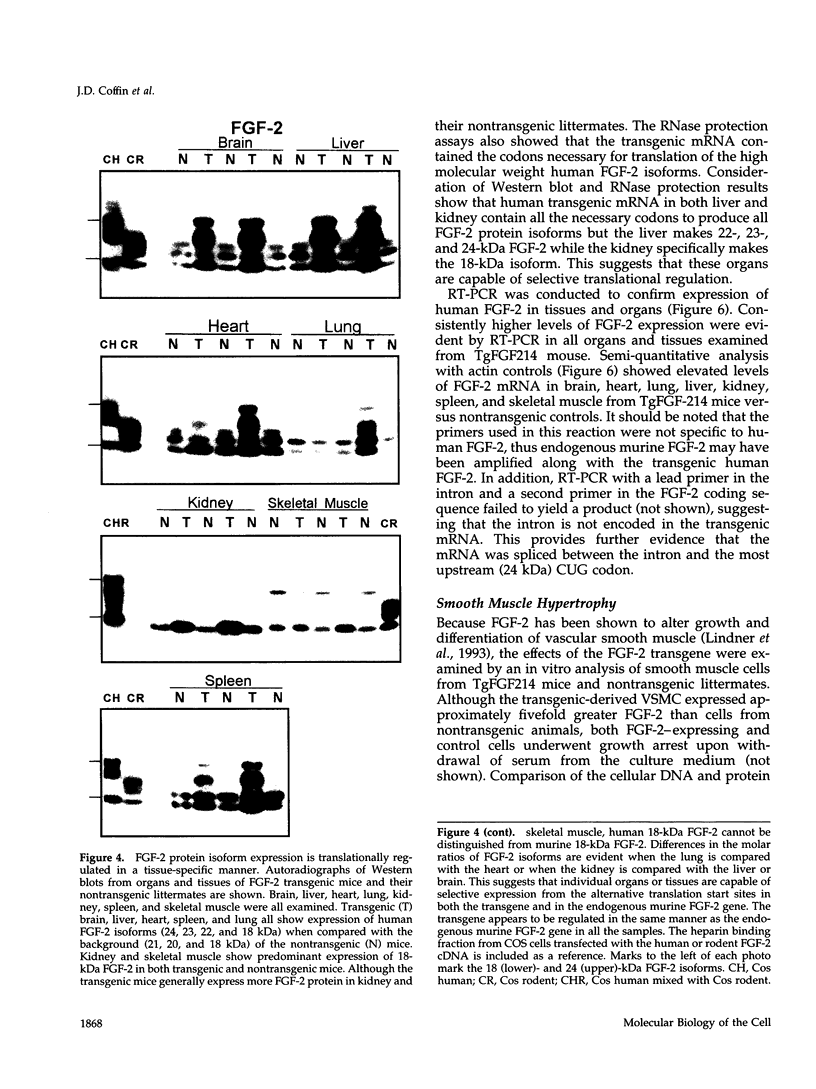
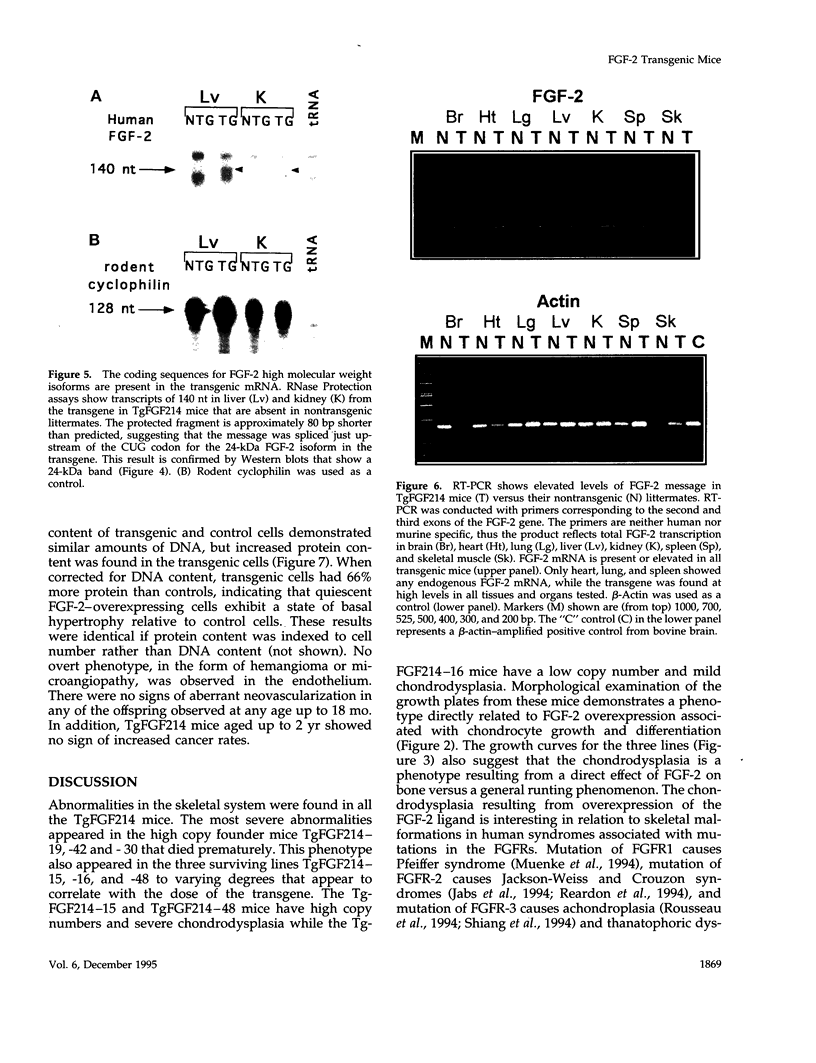
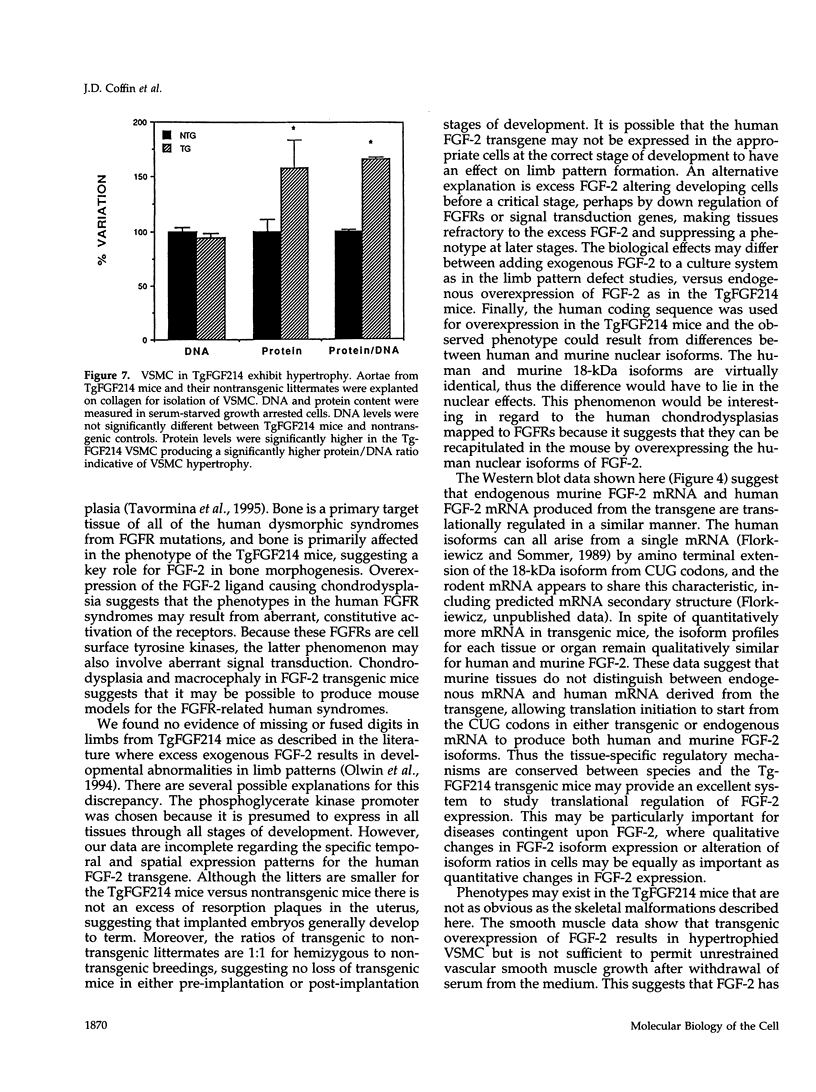
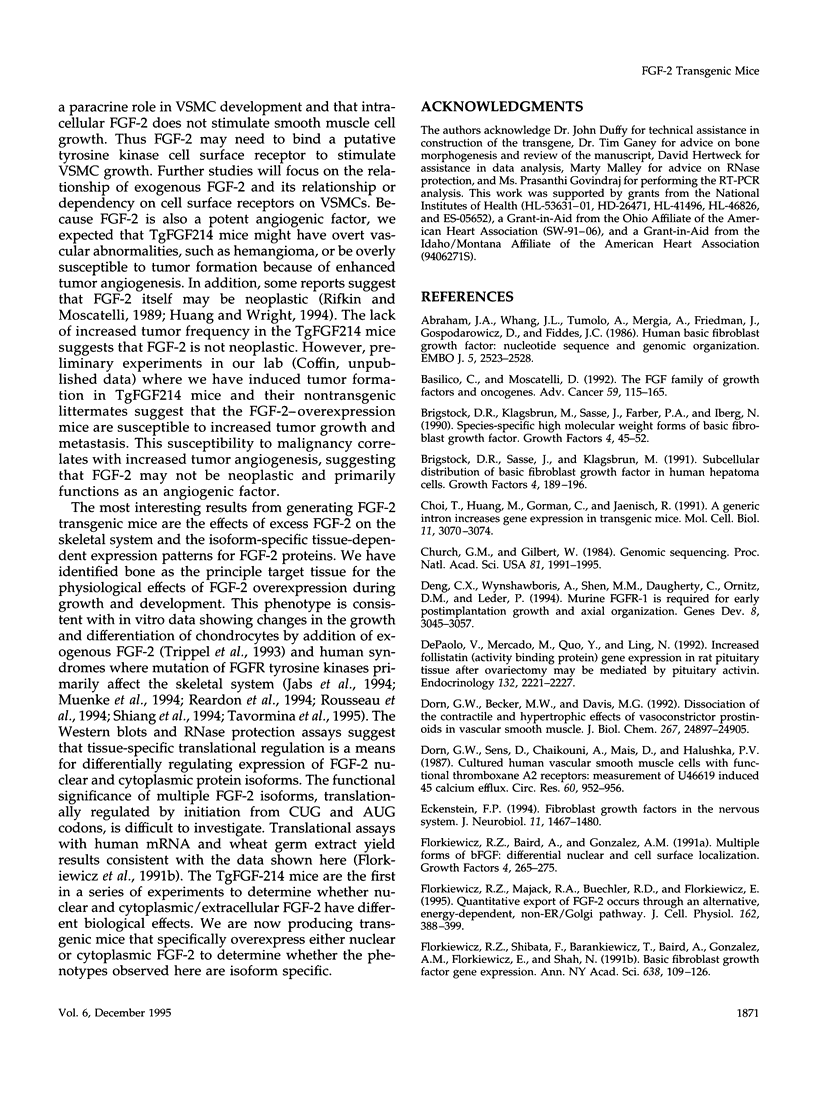
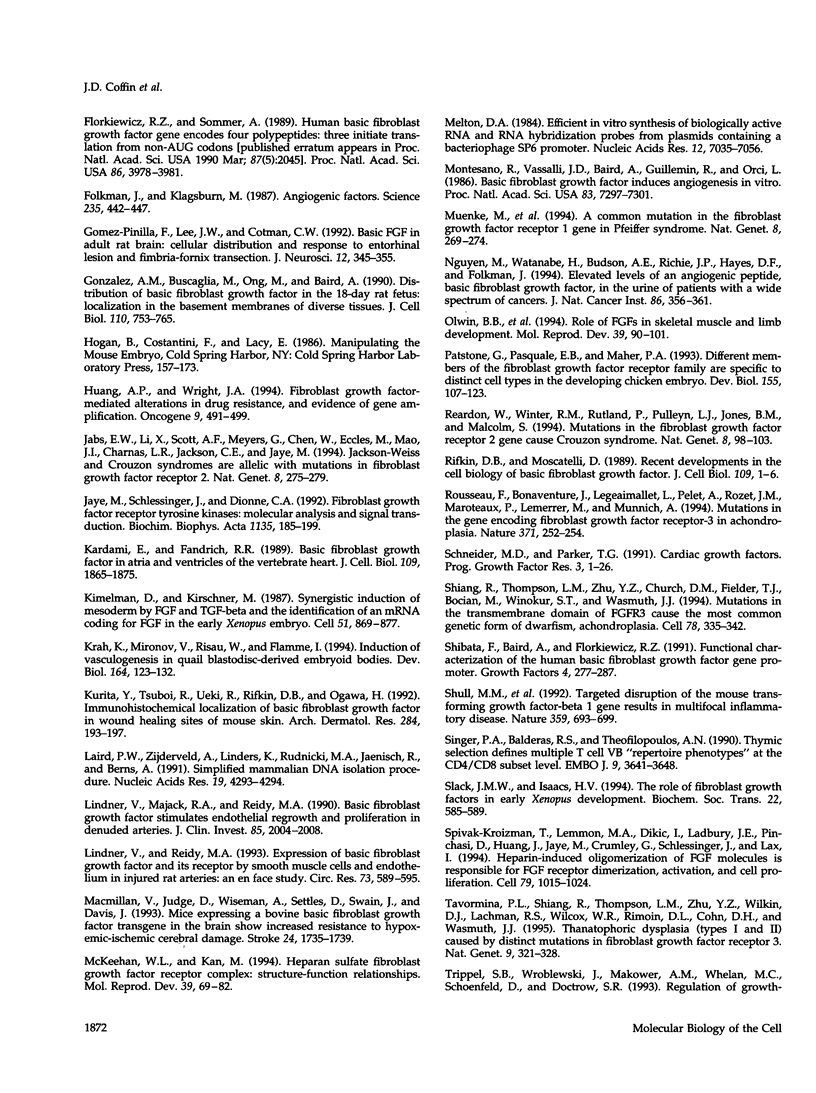
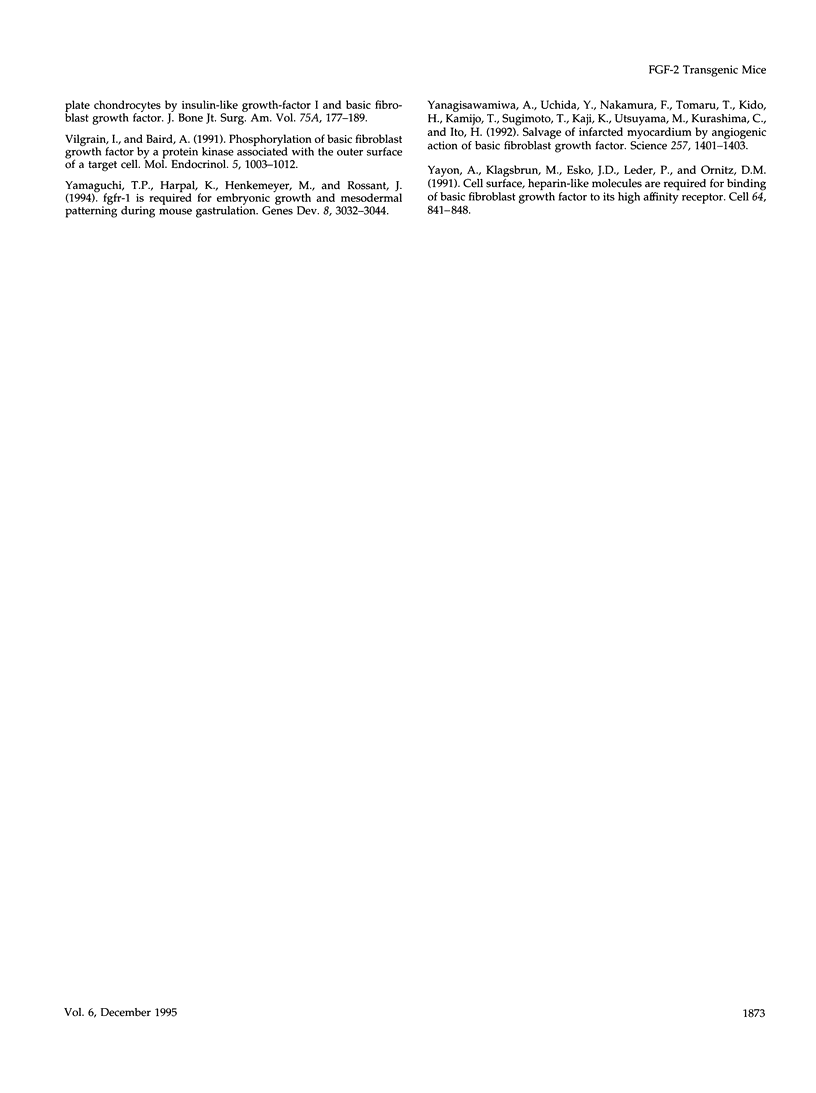
Images in this article
Selected References
These references are in PubMed. This may not be the complete list of references from this article.
- Abraham J. A., Whang J. L., Tumolo A., Mergia A., Friedman J., Gospodarowicz D., Fiddes J. C. Human basic fibroblast growth factor: nucleotide sequence and genomic organization. EMBO J. 1986 Oct;5(10):2523–2528. doi: 10.1002/j.1460-2075.1986.tb04530.x. [DOI] [PMC free article] [PubMed] [Google Scholar]
- Basilico C., Moscatelli D. The FGF family of growth factors and oncogenes. Adv Cancer Res. 1992;59:115–165. doi: 10.1016/s0065-230x(08)60305-x. [DOI] [PubMed] [Google Scholar]
- Brigstock D. R., Klagsbrun M., Sasse J., Farber P. A., Iberg N. Species-specific high molecular weight forms of basic fibroblast growth factor. Growth Factors. 1990;4(1):45–52. doi: 10.3109/08977199009011009. [DOI] [PubMed] [Google Scholar]
- Brigstock D. R., Sasse J., Klagsbrun M. Subcellular distribution of basic fibroblast growth factor in human hepatoma cells. Growth Factors. 1991;4(3):189–196. doi: 10.3109/08977199109104815. [DOI] [PubMed] [Google Scholar]
- Choi T., Huang M., Gorman C., Jaenisch R. A generic intron increases gene expression in transgenic mice. Mol Cell Biol. 1991 Jun;11(6):3070–3074. doi: 10.1128/mcb.11.6.3070. [DOI] [PMC free article] [PubMed] [Google Scholar]
- Church G. M., Gilbert W. Genomic sequencing. Proc Natl Acad Sci U S A. 1984 Apr;81(7):1991–1995. doi: 10.1073/pnas.81.7.1991. [DOI] [PMC free article] [PubMed] [Google Scholar]
- DePaolo L. V., Mercado M., Guo Y., Ling N. Increased follistatin (activin-binding protein) gene expression in rat anterior pituitary tissue after ovariectomy may be mediated by pituitary activin. Endocrinology. 1993 May;132(5):2221–2228. doi: 10.1210/endo.132.5.8477666. [DOI] [PubMed] [Google Scholar]
- Deng C. X., Wynshaw-Boris A., Shen M. M., Daugherty C., Ornitz D. M., Leder P. Murine FGFR-1 is required for early postimplantation growth and axial organization. Genes Dev. 1994 Dec 15;8(24):3045–3057. doi: 10.1101/gad.8.24.3045. [DOI] [PubMed] [Google Scholar]
- Dorn G. W., 2nd, Becker M. W., Davis M. G. Dissociation of the contractile and hypertrophic effects of vasoconstrictor prostanoids in vascular smooth muscle. J Biol Chem. 1992 Dec 5;267(34):24897–24905. [PubMed] [Google Scholar]
- Dorn G. W., 2nd, Sens D., Chaikhouni A., Mais D., Halushka P. V. Cultured human vascular smooth muscle cells with functional thromboxane A2 receptors: measurement of U46619-induced 45calcium efflux. Circ Res. 1987 Jun;60(6):952–956. doi: 10.1161/01.res.60.6.952. [DOI] [PubMed] [Google Scholar]
- Eckenstein F. P. Fibroblast growth factors in the nervous system. J Neurobiol. 1994 Nov;25(11):1467–1480. doi: 10.1002/neu.480251112. [DOI] [PubMed] [Google Scholar]
- Florkiewicz R. Z., Baird A., Gonzalez A. M. Multiple forms of bFGF: differential nuclear and cell surface localization. Growth Factors. 1991;4(4):265–275. doi: 10.3109/08977199109043912. [DOI] [PubMed] [Google Scholar]
- Florkiewicz R. Z., Majack R. A., Buechler R. D., Florkiewicz E. Quantitative export of FGF-2 occurs through an alternative, energy-dependent, non-ER/Golgi pathway. J Cell Physiol. 1995 Mar;162(3):388–399. doi: 10.1002/jcp.1041620311. [DOI] [PubMed] [Google Scholar]
- Florkiewicz R. Z., Shibata F., Barankiewicz T., Baird A., Gonzalez A. M., Florkiewicz E., Shah N. Basic fibroblast growth factor gene expression. Ann N Y Acad Sci. 1991;638:109–126. doi: 10.1111/j.1749-6632.1991.tb49022.x. [DOI] [PubMed] [Google Scholar]
- Florkiewicz R. Z., Sommer A. Human basic fibroblast growth factor gene encodes four polypeptides: three initiate translation from non-AUG codons. Proc Natl Acad Sci U S A. 1989 Jun;86(11):3978–3981. doi: 10.1073/pnas.86.11.3978. [DOI] [PMC free article] [PubMed] [Google Scholar]
- Folkman J., Klagsbrun M. Angiogenic factors. Science. 1987 Jan 23;235(4787):442–447. doi: 10.1126/science.2432664. [DOI] [PubMed] [Google Scholar]
- Gonzalez A. M., Buscaglia M., Ong M., Baird A. Distribution of basic fibroblast growth factor in the 18-day rat fetus: localization in the basement membranes of diverse tissues. J Cell Biol. 1990 Mar;110(3):753–765. doi: 10.1083/jcb.110.3.753. [DOI] [PMC free article] [PubMed] [Google Scholar]
- Gómez-Pinilla F., Lee J. W., Cotman C. W. Basic FGF in adult rat brain: cellular distribution and response to entorhinal lesion and fimbria-fornix transection. J Neurosci. 1992 Jan;12(1):345–355. doi: 10.1523/JNEUROSCI.12-01-00345.1992. [DOI] [PMC free article] [PubMed] [Google Scholar]
- Huang A., Wright J. A. Fibroblast growth factor mediated alterations in drug resistance, and evidence of gene amplification. Oncogene. 1994 Feb;9(2):491–499. [PubMed] [Google Scholar]
- Jabs E. W., Li X., Scott A. F., Meyers G., Chen W., Eccles M., Mao J. I., Charnas L. R., Jackson C. E., Jaye M. Jackson-Weiss and Crouzon syndromes are allelic with mutations in fibroblast growth factor receptor 2. Nat Genet. 1994 Nov;8(3):275–279. doi: 10.1038/ng1194-275. [DOI] [PubMed] [Google Scholar]
- Jaye M., Schlessinger J., Dionne C. A. Fibroblast growth factor receptor tyrosine kinases: molecular analysis and signal transduction. Biochim Biophys Acta. 1992 Jun 10;1135(2):185–199. doi: 10.1016/0167-4889(92)90136-y. [DOI] [PubMed] [Google Scholar]
- Kardami E., Fandrich R. R. Basic fibroblast growth factor in atria and ventricles of the vertebrate heart. J Cell Biol. 1989 Oct;109(4 Pt 1):1865–1875. doi: 10.1083/jcb.109.4.1865. [DOI] [PMC free article] [PubMed] [Google Scholar]
- Kimelman D., Kirschner M. Synergistic induction of mesoderm by FGF and TGF-beta and the identification of an mRNA coding for FGF in the early Xenopus embryo. Cell. 1987 Dec 4;51(5):869–877. doi: 10.1016/0092-8674(87)90110-3. [DOI] [PubMed] [Google Scholar]
- Krah K., Mironov V., Risau W., Flamme I. Induction of vasculogenesis in quail blastodisc-derived embryoid bodies. Dev Biol. 1994 Jul;164(1):123–132. doi: 10.1006/dbio.1994.1185. [DOI] [PubMed] [Google Scholar]
- Kurita Y., Tsuboi R., Ueki R., Rifkin D. B., Ogawa H. Immunohistochemical localization of basic fibroblast growth factor in wound healing sites of mouse skin. Arch Dermatol Res. 1992;284(4):193–197. doi: 10.1007/BF00375792. [DOI] [PubMed] [Google Scholar]
- Laird P. W., Zijderveld A., Linders K., Rudnicki M. A., Jaenisch R., Berns A. Simplified mammalian DNA isolation procedure. Nucleic Acids Res. 1991 Aug 11;19(15):4293–4293. doi: 10.1093/nar/19.15.4293. [DOI] [PMC free article] [PubMed] [Google Scholar]
- Lindner V., Majack R. A., Reidy M. A. Basic fibroblast growth factor stimulates endothelial regrowth and proliferation in denuded arteries. J Clin Invest. 1990 Jun;85(6):2004–2008. doi: 10.1172/JCI114665. [DOI] [PMC free article] [PubMed] [Google Scholar]
- Lindner V., Reidy M. A. Expression of basic fibroblast growth factor and its receptor by smooth muscle cells and endothelium in injured rat arteries. An en face study. Circ Res. 1993 Sep;73(3):589–595. doi: 10.1161/01.res.73.3.589. [DOI] [PubMed] [Google Scholar]
- MacMillan V., Judge D., Wiseman A., Settles D., Swain J., Davis J. Mice expressing a bovine basic fibroblast growth factor transgene in the brain show increased resistance to hypoxemic-ischemic cerebral damage. Stroke. 1993 Nov;24(11):1735–1739. doi: 10.1161/01.str.24.11.1735. [DOI] [PubMed] [Google Scholar]
- McKeehan W. L., Kan M. Heparan sulfate fibroblast growth factor receptor complex: structure-function relationships. Mol Reprod Dev. 1994 Sep;39(1):69–82. doi: 10.1002/mrd.1080390112. [DOI] [PubMed] [Google Scholar]
- Melton D. A., Krieg P. A., Rebagliati M. R., Maniatis T., Zinn K., Green M. R. Efficient in vitro synthesis of biologically active RNA and RNA hybridization probes from plasmids containing a bacteriophage SP6 promoter. Nucleic Acids Res. 1984 Sep 25;12(18):7035–7056. doi: 10.1093/nar/12.18.7035. [DOI] [PMC free article] [PubMed] [Google Scholar]
- Montesano R., Vassalli J. D., Baird A., Guillemin R., Orci L. Basic fibroblast growth factor induces angiogenesis in vitro. Proc Natl Acad Sci U S A. 1986 Oct;83(19):7297–7301. doi: 10.1073/pnas.83.19.7297. [DOI] [PMC free article] [PubMed] [Google Scholar]
- Muenke M., Schell U., Hehr A., Robin N. H., Losken H. W., Schinzel A., Pulleyn L. J., Rutland P., Reardon W., Malcolm S. A common mutation in the fibroblast growth factor receptor 1 gene in Pfeiffer syndrome. Nat Genet. 1994 Nov;8(3):269–274. doi: 10.1038/ng1194-269. [DOI] [PubMed] [Google Scholar]
- Nguyen M., Watanabe H., Budson A. E., Richie J. P., Hayes D. F., Folkman J. Elevated levels of an angiogenic peptide, basic fibroblast growth factor, in the urine of patients with a wide spectrum of cancers. J Natl Cancer Inst. 1994 Mar 2;86(5):356–361. doi: 10.1093/jnci/86.5.356. [DOI] [PubMed] [Google Scholar]
- Olwin B. B., Arthur K., Hannon K., Hein P., McFall A., Riley B., Szebenyi G., Zhou Z., Zuber M. E., Rapraeger A. C. Role of FGFs in skeletal muscle and limb development. Mol Reprod Dev. 1994 Sep;39(1):90–101. doi: 10.1002/mrd.1080390114. [DOI] [PubMed] [Google Scholar]
- Patstone G., Pasquale E. B., Maher P. A. Different members of the fibroblast growth factor receptor family are specific to distinct cell types in the developing chicken embryo. Dev Biol. 1993 Jan;155(1):107–123. doi: 10.1006/dbio.1993.1011. [DOI] [PubMed] [Google Scholar]
- Reardon W., Winter R. M., Rutland P., Pulleyn L. J., Jones B. M., Malcolm S. Mutations in the fibroblast growth factor receptor 2 gene cause Crouzon syndrome. Nat Genet. 1994 Sep;8(1):98–103. doi: 10.1038/ng0994-98. [DOI] [PubMed] [Google Scholar]
- Rifkin D. B., Moscatelli D. Recent developments in the cell biology of basic fibroblast growth factor. J Cell Biol. 1989 Jul;109(1):1–6. doi: 10.1083/jcb.109.1.1. [DOI] [PMC free article] [PubMed] [Google Scholar]
- Rousseau F., Bonaventure J., Legeai-Mallet L., Pelet A., Rozet J. M., Maroteaux P., Le Merrer M., Munnich A. Mutations in the gene encoding fibroblast growth factor receptor-3 in achondroplasia. Nature. 1994 Sep 15;371(6494):252–254. doi: 10.1038/371252a0. [DOI] [PubMed] [Google Scholar]
- Schneider M. D., Parker T. G. Cardiac growth factors. Prog Growth Factor Res. 1991;3(1):1–26. doi: 10.1016/0955-2235(91)90010-2. [DOI] [PubMed] [Google Scholar]
- Shiang R., Thompson L. M., Zhu Y. Z., Church D. M., Fielder T. J., Bocian M., Winokur S. T., Wasmuth J. J. Mutations in the transmembrane domain of FGFR3 cause the most common genetic form of dwarfism, achondroplasia. Cell. 1994 Jul 29;78(2):335–342. doi: 10.1016/0092-8674(94)90302-6. [DOI] [PubMed] [Google Scholar]
- Shibata F., Baird A., Florkiewicz R. Z. Functional characterization of the human basic fibroblast growth factor gene promoter. Growth Factors. 1991;4(4):277–287. doi: 10.3109/08977199109043913. [DOI] [PubMed] [Google Scholar]
- Shull M. M., Ormsby I., Kier A. B., Pawlowski S., Diebold R. J., Yin M., Allen R., Sidman C., Proetzel G., Calvin D. Targeted disruption of the mouse transforming growth factor-beta 1 gene results in multifocal inflammatory disease. Nature. 1992 Oct 22;359(6397):693–699. doi: 10.1038/359693a0. [DOI] [PMC free article] [PubMed] [Google Scholar]
- Singer P. A., Balderas R. S., Theofilopoulos A. N. Thymic selection defines multiple T cell receptor V beta 'repertoire phenotypes' at the CD4/CD8 subset level. EMBO J. 1990 Nov;9(11):3641–3648. doi: 10.1002/j.1460-2075.1990.tb07575.x. [DOI] [PMC free article] [PubMed] [Google Scholar]
- Slack J. M., Isaacs H. V. The role of fibroblast growth factors in early Xenopus development. Biochem Soc Trans. 1994 Aug;22(3):585–589. doi: 10.1042/bst0220585. [DOI] [PubMed] [Google Scholar]
- Spivak-Kroizman T., Lemmon M. A., Dikic I., Ladbury J. E., Pinchasi D., Huang J., Jaye M., Crumley G., Schlessinger J., Lax I. Heparin-induced oligomerization of FGF molecules is responsible for FGF receptor dimerization, activation, and cell proliferation. Cell. 1994 Dec 16;79(6):1015–1024. doi: 10.1016/0092-8674(94)90032-9. [DOI] [PubMed] [Google Scholar]
- Tavormina P. L., Shiang R., Thompson L. M., Zhu Y. Z., Wilkin D. J., Lachman R. S., Wilcox W. R., Rimoin D. L., Cohn D. H., Wasmuth J. J. Thanatophoric dysplasia (types I and II) caused by distinct mutations in fibroblast growth factor receptor 3. Nat Genet. 1995 Mar;9(3):321–328. doi: 10.1038/ng0395-321. [DOI] [PubMed] [Google Scholar]
- Trippel S. B., Wroblewski J., Makower A. M., Whelan M. C., Schoenfeld D., Doctrow S. R. Regulation of growth-plate chondrocytes by insulin-like growth-factor I and basic fibroblast growth factor. J Bone Joint Surg Am. 1993 Feb;75(2):177–189. doi: 10.2106/00004623-199302000-00004. [DOI] [PubMed] [Google Scholar]
- Vilgrain I., Baird A. Phosphorylation of basic fibroblast growth factor by a protein kinase associated with the outer surface of a target cell. Mol Endocrinol. 1991 Jul;5(7):1003–1012. doi: 10.1210/mend-5-7-1003. [DOI] [PubMed] [Google Scholar]
- Yamaguchi T. P., Harpal K., Henkemeyer M., Rossant J. fgfr-1 is required for embryonic growth and mesodermal patterning during mouse gastrulation. Genes Dev. 1994 Dec 15;8(24):3032–3044. doi: 10.1101/gad.8.24.3032. [DOI] [PubMed] [Google Scholar]
- Yanagisawa-Miwa A., Uchida Y., Nakamura F., Tomaru T., Kido H., Kamijo T., Sugimoto T., Kaji K., Utsuyama M., Kurashima C. Salvage of infarcted myocardium by angiogenic action of basic fibroblast growth factor. Science. 1992 Sep 4;257(5075):1401–1403. doi: 10.1126/science.1382313. [DOI] [PubMed] [Google Scholar]
- Yayon A., Klagsbrun M., Esko J. D., Leder P., Ornitz D. M. Cell surface, heparin-like molecules are required for binding of basic fibroblast growth factor to its high affinity receptor. Cell. 1991 Feb 22;64(4):841–848. doi: 10.1016/0092-8674(91)90512-w. [DOI] [PubMed] [Google Scholar]



